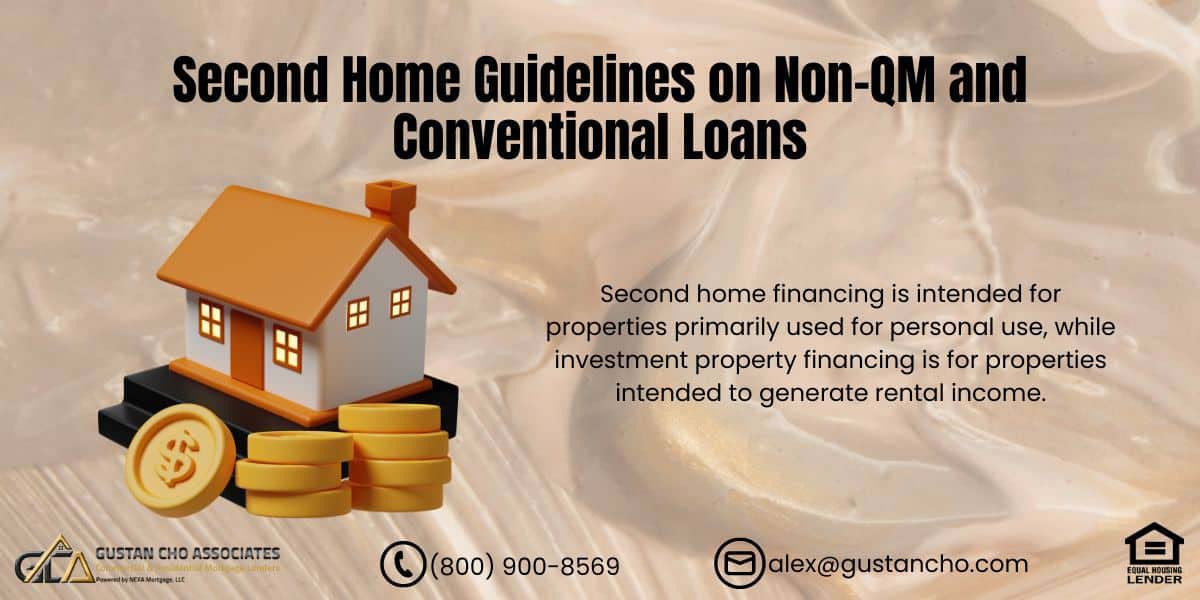This guide covers second home guidelines on non-QM and conventional loans. Second-home financing is different than investment properties. Homebuyers are eligible to finance second and investment homes with conventional loans. However, lenders consider investment homes higher risk than second home financing.
Therefore, higher risk means higher rates and more down payment. This is why many second-home buyers want to make sure the second home they are buying is classified as a second home and not an investment property. There are strict second home lending guidelines for a property to be considered a second home and not an investment property. In the following paragraphs, we will cover second home guidelines on non-QM and conventional loans.
What Classifies a Second Home
There are various reasons why home buyers a second home. Per second home guidelines, a second home cannot be used for investment purposes. Fannie Mae and Freddie Mac have investment property loans. However, investment homes are considered riskier investments than primary or second home investments by lenders.
Therefore, mortgage rates are much higher on investment home financing versus second home financing. Per Second Home Guidelines, a second home needs to be at least 100 or more miles from the primary home.
Or it can be less than 100 miles to the primary home if the proposed second home purchase is a waterfront property, golf course community, or in a high-profile entertainment center like Orlando’s Walt Disney World. In this blog, we will discuss second home guidelines and requirements on non-QM and conventional loans.
Looking to Buy a Second Home? Explore Non-QM and Conventional Loan Options Today!
Contact us today to learn about second home guidelines for Non-QM and conventional loans.Second Home Guidelines on What Classifies as a Second Home
Government Loans (FHA, VA, USDA) are for owner-occupant properties only. Borrowers cannot qualify for second home financing with government loans. Second-home mortgages are conventional loans. Second home mortgage rates are similar to primary mortgage rates.
Second-home rates are much lower than mortgage rates on investment homes. This is why many home buyers want second home financing versus investment homes. Down payment requirements on second homes is 10% versus 20% on investment homes. Owning second homes can benefit investors due to potential appreciation and writing off the second off from the income taxes. Second homeowners can also rent out their second homes when they are not occupying them during and off-season.
Second Home Guidelines: Non-QM and Conventional Loans
When purchasing a second home, it’s important to understand the differences between Non-Qualified Mortgages (non-QM) and conventional loans, as each has its own set of guidelines and requirements.
Second Home Guidelines on Conventional Loans
A credit score of at least 620 is typically required on conventional loans. Higher scores will qualify you for better interest rates. A minimum down payment of 10% is generally required, although 20% or more is recommended to avoid private mortgage insurance (PMI).
Lenders prefer a DTI ratio below 43%, although some may accept up to 50% with compensating factors. Proof of stable income and employment is necessary. This usually includes pay stubs, W-2s, and tax returns. The property must be used primarily for personal use. Occasional rental use is acceptable but cannot be a rental or investment property.
Interest Rates and Terms on Conventional Loans
Interest Rates: Second-home loans often have slightly higher interest rates than primary residence loans due to the increased risk to the lender. Typical loan terms are 15 or 30 years, with fixed and adjustable-rate mortgage (ARM) options available.
Second Home Guidelines on Conventional Loan Limits
Conforming Loan Limits: Subject to the Federal Housing Finance Agency (FHFA) limits, which are $766,550 for most areas but higher in certain high-cost areas.
Second Home Guidelines on Non-QM Loans
Non-QM loans are more flexible with credit scores, sometimes approving scores as low as 580. However, higher scores will benefit from better terms. Due to the higher risk involved, non-QM loans typically require a larger down payment, often 20% or more. Non-QM loans are more flexible with DTI ratios, often allowing up to 50% or higher with sufficient compensating factors.
Non-QM lenders may use alternative methods to verify income, such as bank statements, asset depletion, or profit and loss statements, instead of traditional tax returns and W-2s. Non-QM loans can be used for second homes, investment properties, and vacation homes. The occupancy requirements are more flexible than those of conventional loans.
Interest Rates and Terms on Non-QM Loans
Generally higher than conventional loans due to the increased risk. Rates can vary significantly based on the lender and the borrower’s credit profile. Similar to conventional loans, non-QM loans can have varying terms, including fixed and adjustable rates.
Loan Limits on Non-QM Loans
Non-QM loans are not restricted by conforming loan limits, making them suitable for higher-priced properties. By understanding these guidelines and assessing your financial situation, you can decide which type of loan is best for purchasing your second home.
Second Home Guidelines Benefits and Drawbacks on Non-QM vs Conventional Loans
Benefits of conventional loans are lower interest rates, standardized guidelines, and lower down payment requirements. Drawbacks of conventional loans are stricter credit and income verification requirements, limited DTI flexibility, and lower loan limits.
Drawbacks of Second Home Guidelines on Non-QM Loans
Benefits of non-QM loans is greater flexibility with credit scores, income verification, and DTI ratios; suitable for higher loan amounts. Drawbacks of non-QM loans are higher interest rates and larger down payment requirements. Choosing between a Non-QM and a conventional loan for a second home depends on your financial situation, credit profile, and specific needs.
Non-QM loans offer flexibility for borrowers who may need to meet the strict criteria of conventional loans. In contrast, conventional loans typically offer lower interest rates and standardized terms.
Ready to Purchase a Second Home? Learn About Non-QM and Conventional Loan Guidelines!
Reach out today to understand the guidelines for Non-QM and conventional loans and see how we can help you secure a loan.Second Home Guidelines and Eligibility Requirements
In this section, we will cover some general Fannie Mae and Freddie Mac guidelines on second home loans. Borrowers need to meet Fannie Mae and Freddie Mac Guidelines. 620 minimum credit scores. Homeowners must occupy the second home as a vacation home and not an investment rental.
One unit single-family homes, condominiums, townhouse, PUD. The home must be available for occupancy 12 months out of a year. The home cannot be an income-generating unit nor have any type of timeshare arrangements. The second home down payment requirement is 10% for a 1 unit – maximum loan-to-value is 90%. Private mortgage insurance is required on any conventional loans with higher than 80% loan-to-value.
Investment Versus Second Home Guidelines on Down Payment Requirements
Investment properties are considered riskier investments. Therefore, mortgage rates are higher than second home mortgage rates. Investment Homes require higher down payment than second homes. In this section, we will cover the down payment requirements on investment properties: The minimum down payment on one-unit investment properties is 15% or 85% LTV.
Two to four-unit investment properties require a 25% down payment or 75% Loan-To-Value. For the best mortgage rates on investment property loans, borrowers should put a 25% to 30% down payment. Investment property owners can do a cash-out refinance of up to 75% loan-to-value on one to four-unit properties.
Examples of Second Home Guidelines Versus Investment Homes
Mortgage Underwriters need to determine whether the potential purchase is a second home versus an investment home. For example, if a homeowner has a primary residence in Lombard, Illinois, and wants to purchase a Lake Michigan waterfront condo that is 30 miles away, it will be classified as a second home.
However, if Lombard, Illinois has a 2,000 square foot home and wants to purchase a second 2,000 square foot home in Chicago, then it would be classified as an investment home and not a second home. If the same Lombard, Illinois homeowner wants to purchase a 2,000 square feet second home in Kentucky because they have kids and friends there, then the second home purchase would be classified as a second home.
FAQs: Second Home Guidelines on Non-QM and Conventional Loans
-
-
1. What is the difference between second home financing and investment property financing? Second home financing is intended for properties primarily used for personal use, while investment property financing is for properties intended to generate rental income. Lenders view investment properties as posing a greater risk, leading to increased interest rates and more substantial down payment obligations than second homes.
-
2. What classifies a property as a second home? A second home must be primarily for personal use and not for investment purposes. It must be at least 100 miles from the primary residence unless it’s in a desirable location, such as a waterfront property, golf course community, or high-profile entertainment area.
-
3. Can a second home be rented out? Yes, a second home can be rented out occasionally but cannot be primarily used as a rental or investment property.
-
4. What are the key differences between non-QM and conventional loans for second homes? Non-QM loans offer more flexibility in credit scores, income verification, and debt-to-income (DTI) ratios, while conventional loans have stricter guidelines but typically offer lower interest rates.
-
5. What are the down payment requirements for second homes? For conventional loans, the minimum down payment is 10%. Non-QM loans usually require a larger down payment, often 20% or more, due to the higher risk involved.
-
6. What are the credit score requirements for second home loans? Conventional loans generally require a credit score of at least 620. Non-QM loans may approve scores as low as 580, but higher scores will secure better terms.
-
7. How do interest rates for second home loans compare to primary residence loans? The interest rates for second home loans are typically higher than primary residence loans because they pose a greater risk to the lender.
-
8. What are the typical loan terms for second home loans? Loan terms are typically 15 or 30 years, with fixed and adjustable-rate mortgage (ARM) options available.
-
9. Are there any limits on the amount borrowed for a second home? Conventional loans are subject to Federal Housing Finance Agency (FHFA) limits, which are $766,550 for most areas but higher in certain high-cost areas. Non-QM loans are not restricted by these limits, making them suitable for higher-priced properties.
-
10. What are the benefits of conventional loans for second homes? Conventional loans typically offer lower interest rates, standardized guidelines, and lower down payment requirements than non-QM loans.
-
11. What are the drawbacks of non-QM loans for second homes? Non-QM loans generally have higher interest rates and larger down payment requirements but offer greater flexibility with credit scores, income verification, and DTI ratios.
-
12. What are the general eligibility requirements for second home loans under the guidelines of Fannie Mae and Freddie Mac? Borrowers must have a minimum credit score of 620, occupy the home as a vacation home (not a rental), and the property must be a single-family home, condominium, townhouse, or PUD available for occupancy 12 months a year. The second home cannot be an income-generating unit or part of a timeshare arrangement. A 10% down payment is required, and private mortgage insurance is necessary for loans with higher than 80% loan-to-value.
-
13. How do down payment requirements for investment properties compare to second homes? Investment properties require higher down payments—typically a minimum of 15% for one-unit properties and 25% for two to four-unit properties. Second homes, on the other hand, generally require a 10% down payment.
-
14. Can investment property owners do a cash-out refinance? They can do a cash-out refinance of up to 75% loan-to-value on one- to four-unit properties.
-
By understanding these guidelines and assessing your financial situation, you can decide which type of loan is best for purchasing your second home.










